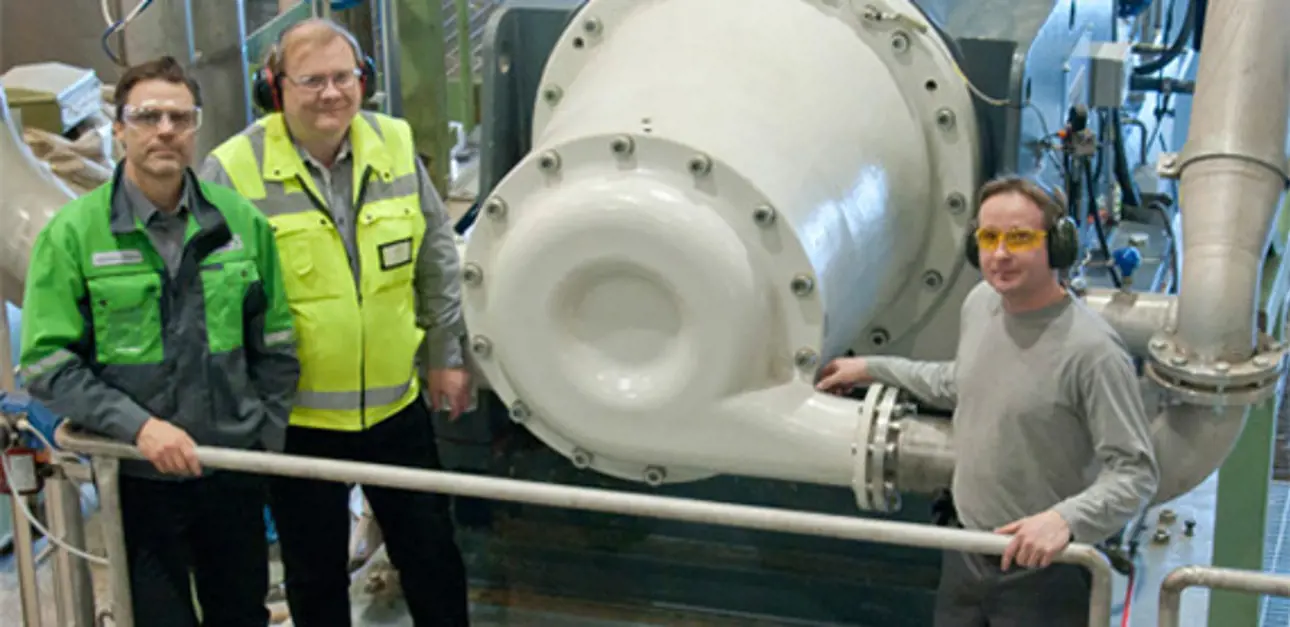High performance reliability with refining rebuild
May 28, 2015

The world’s biggest OptiFiner Pro refiner saves energy at Savon Sellu.
Juha-Pekka Huhtanen (Valmet, left), Tapio Laukkanen and Antti Jegoroff (Savon Sellu).
High-performance reliability - that is the one thing both Powerflute corrugated boxes and Valmet’s OptiFiner Pro refiners have in common. It is only fitting,
that the world’s largest, new-generation high-capacity refiner started up at Savon Sellu, a then Powerflute (now Mondi) operated paper mill at Kuopio, Finland in late 2014.
High-tech refining for high-tech fibers
“The starting point was that we needed to replace our old disc refiners at the first low consistency refining stage because they had reached the end of their lifecycle,” explains Tapio Laukkanen, Technology Manager. “But during the investment project, we realized that the whole refining process needed rethinking in order to ensure capacity. We didn’t settle for the easy solution, but tried to see the forest for the trees, so to speak, and changed our refining approach and optimized the refining process as a whole,” he says.
Now, after the rebuild, the Powerflute NSSC fibers are refined in low energy, two-stage, low consistency refining process that optimizes the stiffness values (CMT and CCT) while providing fluting with both flexibility and strength. The second refining stage was equipped with two of the largest available OptiFiner Pro refiners for high capacity. At the same time, the old refiners equipped with new refiner segments were moved to the first stage. Additionally, a new OptiFiner Conflo refiner was installed beside the existing refiners in the first stage in order to meet capacity demands.
|
Kari Pietikäinen, Operation Manager |
”I was curious whether the new refiner technology would work as said. The construction seemed to make sense and Valmet has a reliable reputation. The new system has worked really well from the beginning. We consume now almost 30% less energy to the same end-product quality. The refiner segments were just changed for the first time, they lasted half a year. “ |
| ”We had plenty of hassle with the old refiners like segment wearing issues. There was much more need for manual operation and control, too. Now the paper machine is running smoothly, refining result is more even and there is much less fiber bundless causing breaks. “ |
Antti Jegoroff,
Machine Operator
|
|
Tapio Laukkanen, Technology Manager |
“We didn’t settle for the easy solution and changed the refining philosophy and optimized the refining process as a whole. Together with Valmet we found out the key solution, OptiFiner Pro.” |
Better performance, lower costs
“The new OptiFiner Pro refiners have been working very well. We are now able to control the refining process much more accurately and the process tolerates more variation,” Laukkanen explains. “We believe that the unique refining principle of the OptiFiner Pro gives us an advantage because the refining efficiency is good and the fiber is refined better. If we gain energy savings at the same time, well, that’s an added bonus,” he continues with a smile. In this respect, Laukkanen says, the bonus is up to 30% less energy used, while achieving the same freeness values as before.
“Our primary goal is to improve end-product quality and for that, we are continuing our good co-operation with Valmet. The design of the new refiner segments and running speeds in the first refining stage still require optimization to fully meet the requirements set by the raw material, but the potential of the OptiFiner Pro refiners is evident before our eyes,” enthuses Laukkanen.
Life-cycle costs matter
“When deciding on the investment, we made careful life cycle cost calculations for each solution. We wanted to compare both investment and maintenance costs together over the next ten years,” says Laukkanen. “It is a bit early to say, but we believe that with proper preventive maintenance the maintenance cost will be lower with the OptiFiner refiners.” With a refiner segment life of six months, the mill has already witnessed proof of the reliability of the new system compared to the old one.


